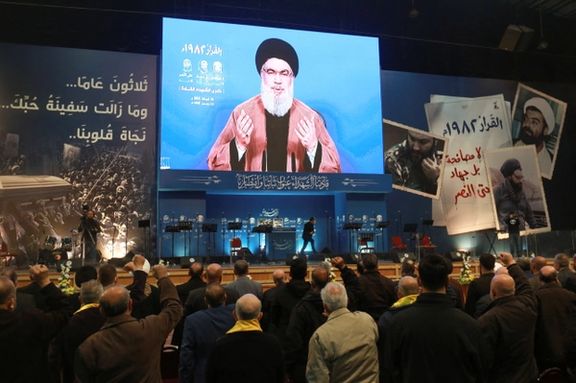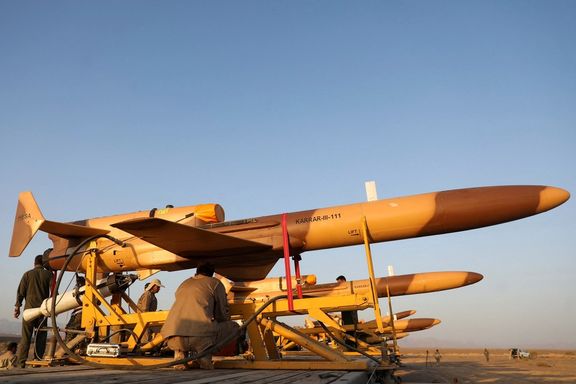Iranian Media Claim Hezbollah Leader Suffering From Flu

Following reports that Hezbollah leader Hassan Nasrallah had a second stroke, Iranian state media quoted an “informed source” that he has only contracted influenza.

Following reports that Hezbollah leader Hassan Nasrallah had a second stroke, Iranian state media quoted an “informed source” that he has only contracted influenza.
The source told IRNA Sunday that Nasrallah has the flu and is "going through his treatment process", however, independent sources and media in Lebanon have not yet confirmed this claim about Nasrallah's illness.
The Hezbollah leader was scheduled to give a speech to his supporters on Friday, but al-Manar TV, affiliated with Hezbollah, said in a statement that the speech was canceled due to Nasrallah's illness.
After that, unofficial reports were published about Nasrallah's "stroke".
Hossein al-Ghawi, a Saudi journalist, wrote in a tweet that Nasrallah was transferred to a hospital in Beirut after suffering a second stroke.
In recent years, numerous reports have been published about Nasrallah's physical condition.
Four years ago, reports about Nasrallah's "heart attack" were published, but Hossein Amir-Abdollahian, who was the foreign policy advisor to Iran’s parliament speaker at the time, denied it.
Groups like Hezbollah and governments like the Islamic Republic do not provide clear and accurate information about the physical condition of their leaders.
Hezbollah, supported by the Islamic Republic, is recognized as a terrorist group by several countries, including the United States.

An Iranian official has said that around 800 Starlink satellite internet receivers have been imported to Iran, saying the technology would be used more in future.
Head of the Tehran Telecom Traders Union Mehdi Mohebi quoted an “official” who did not want to reveal his identity that 800 Starlink satellite internet terminals have entered the country so far.
This comes as the American tycoon Elon Musk said last week that the use of satellite internet services in Iran has increased and around 100 Starlink devices are active in the country now.
Musk said in a tweet that “approaching 100 Starlinks active in Iran”, three months after he confirmed he would activate the service in the country to help Iranians circumvent internet restrictions imposed by the government amid nationwide protests.
Back in September the billionaire, who is now also a social media player by controlling Twitter, had announced he would activate Starlink in Iran as part of the United States’ effort “to advance internet freedom” and facilitate “the free flow of information” to Iranians.
The Iranian regime has been severely restricting Internet access in general and access to popular social media platforms, such as Instagram, in particular that play a key role in protester communications. These restrictions have caused many problems for those who rely on social media to promote their businesses and hugely damaged e-commerce.
It is not clear who are the importers of the receivers, which the government views as illegal. Most likely, the devices are brought from across the borders by small-time smugglers.

The Iranian military says it launched a drone to warn off a reconnaissance plane trying to approach Iranian war games near the Persian Gulf.
Fars News Agency, affiliated to the Revolutionary Guard, said Saturday that the warning procedure was carried out by Iranian drone Karrar; however, it did not specify the nationality of the reconnaissance aircraft.
The US State Department has refused to comment on the report referring questions to the Pentagon, which declined to comment as well, according to Reuters.
Iran’s military began to test new attack drones in the coastal area of the Gulf of Oman and near the strategic Strait of Hormuz since Thursday as part of its annual drills.
“During the exercises, a P-8 manned intelligence aircraft belonging to extra-regional forces, which had tried to reduce altitude to collect more accurate information from the exercise area, was forced to leave the area by the firing of a Karrar drone by (Iran's) air defense,” Fars reported.
Last week, top Iranian military official General Mohammad Bagheri said the Islamic Republic will continue to develop drones according to its interests and Tehran will cooperate with other countries in this regard.
According to IRNA, Chief of General Staff of the Iranian Armed Forces said the country’s UAVs are accurate enough to respond to any threat endangering its interests.
Bagheri, however, did not name any specific country with which the Islamic Republic is cooperating to develop UAVs.

Lebanese media report that Hezbollah is facing financial problems due to the situation in Iran, as it cannot import Iranian goods to sell at a discount to its supporters.
Two years ago, Lebanon's Hezbollah distributed a card called "Sajjad" among the families of its members to buy food stuff with a 60% discount at shops selling Iranian products.
The Lebanese website "Janoubieh" quoted its sources as saying that now shopping with this card has encountered problems.
According to this report, the Islamic Republic is unable to send food items such as cooking oil and tea to Lebanon due anti-regime protests and its economic problems, including the sharp increase of the US dollar against its currency, the rial.
The militant Hezbollah group has reportedly replaced Iranian goods with the Lebanese, Turkish, and Indian items for the users of the Sajjad card.
Makram Rabah, a Lebanese political activist, emphasized in an interview with Iran International that the consequences of the uprising of Iranians against the regime could now be seen in Lebanon.
He said the dire situation of the Islamic Republic, as the biggest financial and political supporter of Hezbollah, causes this group to lose the ability to stand on its own feet.
Earlier, some media, including Jerusalem Post, reported that the Palestinian groups affiliated to the Islamic Republic have also suffered a financial crisis because of troubles Iran faces.

Iran’s battered currency regained 10 percent of its value Saturday after a new central bank chief assumed office following a drop to historic lows in December.
The US dollar dropped to below 400,000 rials from a high of 440,00 earlier this week, a 10-percent gain for the Iranian currency that has fallen more than 10-fold since 2018.
The new central bank chief Mohammad-Reza Farzin announced the bank’s intervention in the market as he began his first official day at work.
“The exchange rate in the open market is exaggerated,” he claimed, although an apparent massive infusion of dollars was needed to reverse rial’s precipitous decline. He added that economic fundamentals do not justify the currency’s fall, insisting that Iran sold $36 billion of oil in the past nine months.
Farzin did not explain why the rial has fallen to unprecedented lows if the country is flushed with hard currency, but he vowed “appropriate intervention” in the market to support the rial.
Even with Saturday’s rise, the currency is still 30 percent lower than in August and almost 50 percent less than in mid-2021, when the current hardliner president Ebrahim Raisi was elected and appointed other hardliners to top positions.
Rial’s current wave of decline began in early 2018 when the United States decided to withdraw from the Obama-era nuclear accord with Iran, known as the JCPOA and impose ‘maximum pressure’ sanctions. The country’s oil exports, its economic lifeline, and international banking came under US third-party sanctions, meaning that any company or country violating the restrictions could itself come under US sanctions.
The rila which was then around 34,000 to the dollar began to fall, with the government forced to offer cheap foreign currency to importers of essential goods, to protect people from an inflationary shock.
The government’s fixed-rate 42,000 rials for one dollar soon became a source of abuse by people who claimed to be importing essential goods, like food or raw materials, and instead imported luxury cars or simply turned around and sold the cheap dollars on the free market making huge profits.
The government began restricting the availability of dollars at 42,000 rials and earlier this year completely ceased the practice, saving around $15 billion annually, but accelerating food price inflation. In effect an important subsidy was removed, raising food, animal feed and medicine prices.
Following this inflationary shock, in early September talks with the US and its European allies to revive the nuclear deal fell apart, signaling a possible worsening of the economy. This triggered a new wave of rial’s de facto devaluation, as it fell in Tehran’s open market. Local reports also have mentioned accelerated capital flight from the country, which might have played a role in the sudden worsening of the exchange rate.
At the same time, nationwide antigovernment protests began in mid-September after Mahsa Amini, a young woman was killed in police custody. The popular uprising created a deeper feeling of instability and uncertainty.
Ali Shariati, a member of Tehran’s chamber of commerce predicted that the rial will be stabilized at 380,00-390,000 to the dollar by the government.
This might be the government’s goal, but to maintain the rial at that range, the central bank will have to continue injecting dollars into the market, a significant part of which simply leaves the country, to the tune of at least $10 billion annually.

Following warnings issued by the western countries about traveling to Iran, the Islamic Republic is to allocate some budget to “counter Iranophobia” in near future.
Iran’s Deputy Tourism Minister Ali-Asghar Shalbafian said Saturday that suggestions have been made for a line of credit for next Iranian year beginning on March 21.
However, he mentioned until the end of current Iranian year on March 20, 2023, the tourism ministry must go ahead with a “limited budget”.
Amid more arrests of dual nationals with Western passports by the Islamic Republic in recent months, several countries have issued warnings to their citizens against traveling to Iran.
The United Kingdom, United States, France, Sweden, Netherland, and Canada advised their nationals not to travel to the Middle Eastern country due to “insecurity” since the nationwide anti-government protests began in Iran in mid-September.
Fearing arrest by Iranian authorities, most foreign tours booked for the New Year and January in popular historic cities have been canceled.
In early November the chairman of the board of Iran's Tour Guides Association, Mohsen Haji-Saeed said some tourists seen in the wrong places and at the wrong time were considered as “spies” and that some foreign nationals had been detained only for taking photographs of the protests “out of curiosity”.
On September 30, Iran’s Intelligence Ministry announced the detention of nine foreign citizens from Germany, Poland, Italy, France, the Netherlands and Sweden. The ministry alleged those arrested had been "on the stage or behind the scenes" of the recent protests.